Decomposition of a Cooling Plant for Energy Efficiency Optimization Using OptTopo
Abstract
1. Introduction
2. Related Work
2.1. Cascade Control for Coupled HVAC Systems
2.2. Multiplexed Real-Time Optimization
2.3. Extremum Seeking Control (ESC)
2.4. Optimization of Machine Tools Using Graph Models
2.5. Multi-Agent Reinforcement Learning (MARL) in Machine Control
2.6. Deep Reinforcement Learning
2.7. Optimization of Parallel Pumps
2.8. Summary of Literature
3. Concept
3.1. General Workflow to Optimize a System Based on Topology
- For each component, assign the absorbed energy flow (e.g., electrical energy), generated output flow (called benefit), control variables, and external influence factors.
- Generate models to predict the in- and outgoing flows of all the subsystems. Since they are separated, these models can be of different forms for different subsystems, like polynomials for one and a neural network for another subsystem.
- Use the system decomposition (step 1) together with the models of the subsystems (step 2) and an objective function as input for an optimization algorithm using this topology.
3.2. Optimization Algorithm Based on Topology
3.3. Boundedness and Discretization
3.4. Topological Sorting and Graph Traversal for Optimization
3.5. Solution Look-Up
4. Implementation and Experiments
- a simulation of a cooling plant mentioned in Section 1 which provides data for model training—and allows to validate the resulting set-points,
- a python project for running different optimization routines on predefined problems,
4.1. Comparison and Benchmarking
4.1.1. Sequential Derivative-free Penalty method (SDPEN)
4.1.2. Constrained Optimization by Linear Approximation (COBYLA)
4.1.3. Convex over and under Envelopes for Nonlinear Estimation (COUENNE)
4.1.4. Comparison
4.2. Experimental Setup
| Cooling Tower | Cooling Water | Chillers | Chilled Water | ||
|---|---|---|---|---|---|
| , | 5 | ||||
| , | 2 | ||||
| 2 | 2 | 4 | 2 |
4.3. Results and Interpretation
4.3.1. Feasibility of the Approach
4.3.2. Comparison to Other Optimization Procedures
4.3.3. Scalability
5. Conclusions and Outlook
Author Contributions
Funding
Institutional Review Board Statement
Informed Consent Statement
Data Availability Statement
Acknowledgments
Conflicts of Interest
References
- Thiele, G.; Clauss, R.; Krüger, J.; Heimann, O. Chiller System Simulation and Optimization. Available online: https://fordatis.fraunhofer.de/handle/fordatis/124 (accessed on 2 November 2022).
- Thiele, G.; Heimann, O.; Grabowski, K.; Krüger, J. Framework for energy efficiency optimization of industrial systems based on the Control Layer Model. Procedia Manuf. 2019, 33, 414–421. [Google Scholar] [CrossRef]
- Grabowski, K.; Kubin, K.; Ernst, C. Energiekennzahl-Methodik zur Überwachung und Bewertung von Anlagen in produzierenden Unternehmen. Energiewirtschaft Tagesfragen 2015, 65. [Google Scholar]
- Thiele, G.; Clauß, R.; Johanni, T.; Krüger, J. Energy optimal set-points for coupled systems using their topology. In Proceedings of the 2020 7th International Conference on Control, Decision and Information Technologies (CoDIT), Prague, Czech Republic, 29 June–2 July 2020; pp. 1052–1057. [Google Scholar] [CrossRef]
- Thiele, G.; Johanni, T.; Sommer, D.; Krüger, J. OptTopo: Automated set-point optimization for coupled systems using topology information. In Proceedings of the 2022 8th International Conference on Control, Decision and Information Technologies (CoDIT), Istanbul, Turkey, 17–20 May 2022; pp. 1052–1057. [Google Scholar]
- Behrooz, F.; Mariun, N.; Marhaban, M.H.; Mohd Radzi, M.A.; Ramli, A.R. Review of Control Techniques for HVAC Systems—Nonlinearity Approaches Based on Fuzzy Cognitive Maps. Energies 2018, 11, 495. [Google Scholar] [CrossRef]
- Komareji, M.; Stoustrup, J.; Rasmussen, H.; Bidstrup, N.; Svendsen, P.; Nielsen, F. Optimal Set-point Synthesis in HVAC Systems. In Proceedings of the American Control Conference, New York, NY, USA, 9–13 July 2007; pp. 5076–5081. [Google Scholar] [CrossRef]
- Komareji, M.; Stoustrup, J.; Rasmussen, H.; Bidstrup, N.; Svendsen, P.; Nielsen, F. Simplified optimal control in HVAC systems. In Proceedings of the 2009 IEEE Control Applications, (CCA) Intelligent Control, (ISIC), St. Petersburg, Russia, 8–10 July 2009; pp. 1033–1038. [Google Scholar] [CrossRef]
- Asad, H.S.; Yuen, R.K.K.; Huang, G. Multiplexed real-time optimization of HVAC systems with enhanced control stability. Appl. Energy 2017, 187, 640–651. [Google Scholar] [CrossRef]
- Asad, H.S.; Yuen, R.K.K.; Huang, G. Degree of freedom based set-point reset scheme for HVAC real-time optimization. Energy Build. 2016, 128, 349–359. [Google Scholar] [CrossRef]
- Asad, H.S.; Yuen, R.K.K.; Liu, J.; Wang, J. Adaptive modeling for reliability in optimal control of complex HVAC systems. Build. Simul. 2019, 12, 1095–1106. [Google Scholar] [CrossRef]
- Mu, B.; Li, Y.; House, J.M.; Salsbury, T.I. Real-time optimization of a chilled water plant with parallel chillers based on extremum seeking control. Appl. Energy 2017, 208, 766–781. [Google Scholar] [CrossRef]
- Tan, Y.; Li, Y.; Mareels, I.M.Y. Extremum Seeking for Constrained Inputs. IEEE Trans. Autom. Control. 2013, 58, 2405–2410. [Google Scholar] [CrossRef]
- Zhao, Z.; Li, Y.; Salsbury, T.I.; House, J.M. Extremum-seeking control integrated online input selection with application to a chilled-water plant. Sci. Technol. Built Environ. 2022, 28, 170–187. [Google Scholar] [CrossRef]
- Eberspächer, P.; Verl, A. Realizing Energy Reduction of Machine Tools Through a Control-integrated Consumption Graph-based Optimization Method. Procedia CIRP 2013, 7, 640–645. [Google Scholar] [CrossRef]
- Schlechtendahl, J.; Eberspächer, P.; Schraml, P.; Verl, A.; Abele, E. Multi-level Energy Demand Optimizer System for Machine Tool Controls. Procedia CIRP 2016, 41, 783–788. [Google Scholar] [CrossRef]
- Bakakeu, J.; Kisskalt, D.; Franke, J.; Baer, S.; Klos, H.H.; Peschke, J. Multi-Agent Reinforcement Learning for the Energy Optimization of Cyber-Physical Production Systems. In Proceedings of the 2020 IEEE Canadian Conference on Electrical and Computer Engineering (CCECE), London, ON, Canada, 30 August–2 September 2020; pp. 1–8. [Google Scholar]
- Bakakeu, J.; Baer, S.; Klos, H.H.; Peschke, J.; Brossog, M.; Franke, J. Multi-Agent Reinforcement Learning for the Energy Optimization of Cyber-Physical Production Systems. In Artificial Intelligence in Industry 4.0: A Collection of Innovative Research Case-Studies that Are Reworking the Way We Look at Industry 4.0 Thanks to Artificial Intelligence; Springer: Berlin/Heidelberg, Germany, 2021; pp. 143–163. [Google Scholar]
- Leibo, J.Z.; Hughes, E.; Lanctot, M.; Graepel, T. Autocurricula and the Emergence of Innovation from Social Interaction: A Manifesto for Multi-Agent Intelligence Research. arXiv 2019, arXiv:1903.00742. [Google Scholar]
- Panten, N. Deep Reinforcement Learning zur Betriebsoptimierung hybrider industrieller Energienetze. Ph.D. Thesis, Technische Universität Darmstadt, Darmstadt, Germany, 2019. [Google Scholar]
- Weigold, M.; Ranzau, H.; Schaumann, S.; Kohne, T.; Panten, N.; Abele, E. Method for the application of deep reinforcement learning for optimised control of industrial energy supply systems by the example of a central cooling system. CIRP Ann. 2021, 70, 17–20. [Google Scholar] [CrossRef]
- Wang, X.; Zhao, Q.; Wang, Y. A Distributed Optimization Method for Energy Saving of Parallel-Connected Pumps in HVAC Systems. Energies 2020, 13, 3927. [Google Scholar] [CrossRef]
- Wang, X.; Zhao, Q.; Wang, Y. An asynchronous distributed optimization method for energy saving of parallel-connected pumps in HVAC systems. Results Control. Optim. 2020, 1, 100001. [Google Scholar] [CrossRef]
- Kahn, A.B. Topological Sorting of Large Networks. Commun. ACM 1962, 5, 558–562. [Google Scholar] [CrossRef]
- Hart, W.E.; Watson, J.P.; Woodruff, D.L. Pyomo: Modeling and solving mathematical programs in Python. Math. Program. Comput. 2011, 3, 219–260. [Google Scholar] [CrossRef]
- Perez, R.E.; Perez, R.E.; Jansen, P.W.; Jansen, P.W.; Martins, J.R.R.A.; Martins, J.R.R.A. pyOpt: A Python-based object-oriented framework for nonlinear constrained optimization. Struct. Multidiscip. Optim. 2012, 45, 101–118. [Google Scholar] [CrossRef]
- Liuzzi, G.; Lucidi, S.; Sciandrone, M. Sequential Penalty Derivative-Free Methods for Nonlinear Constrained Optimization. SIAM J. Optim. 2010, 20, 2614–2635. [Google Scholar] [CrossRef]
- Mangasarian, O.; Fromovitz, S. The Fritz John necessary optimality conditions in the presence of equality and inequality constraints. J. Math. Anal. Appl. 1967, 17, 37–47. [Google Scholar] [CrossRef]
- Powell, M.J.D. A Direct Search Optimization Method That Models the Objective and Constraint Functions by Linear Interpolation. In Advances in Optimization and Numerical Analysis; Gomez, S., Hennart, J.P., Eds.; Springer: Dordrecht, The Netherlands, 1994; pp. 51–67. [Google Scholar]
- Belotti, P.; Lee, J.; Liberti, L.; Margot, F.; Wächter, A. Branching and bounds tighteningtechniques for non-convex MINLP. Optim. Methods Softw. 2009, 24, 597–634. [Google Scholar] [CrossRef]

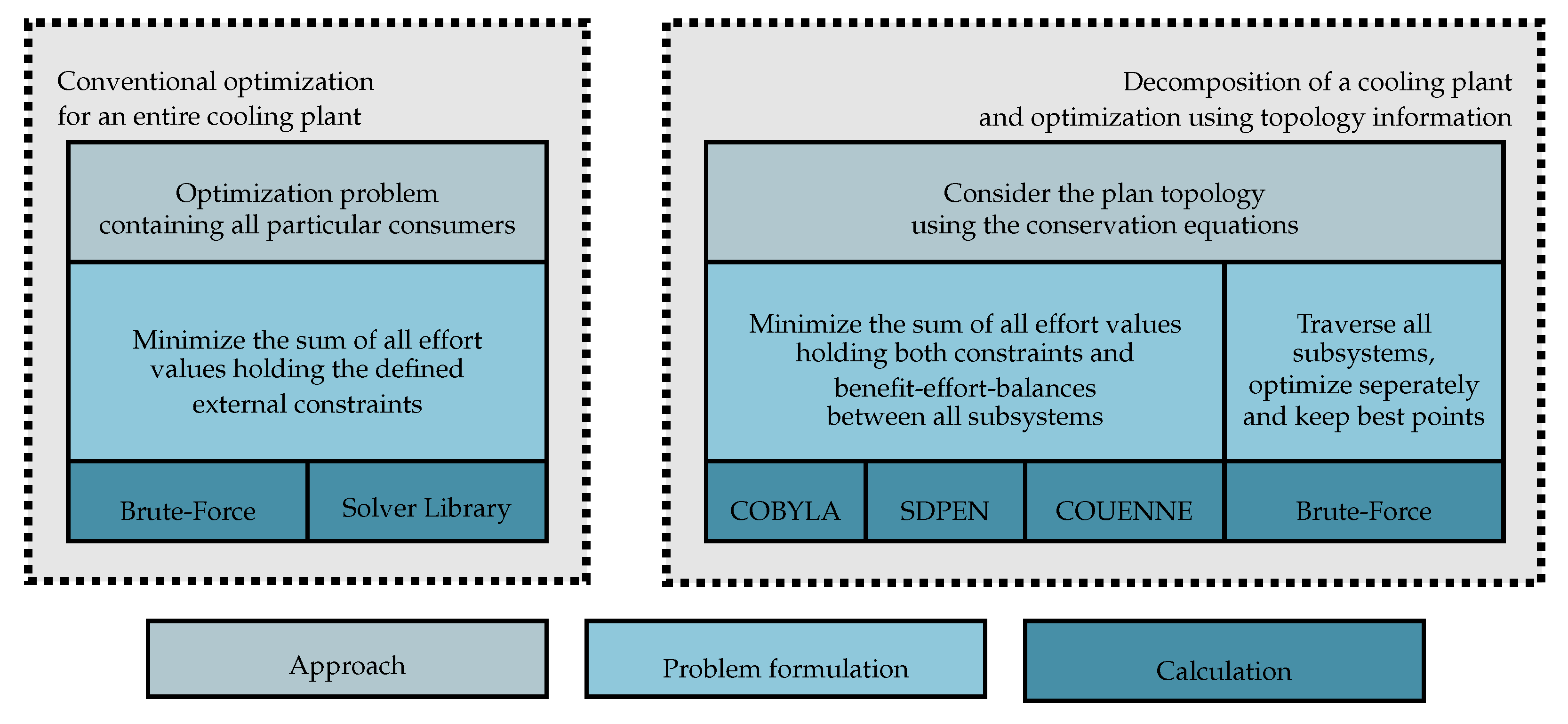
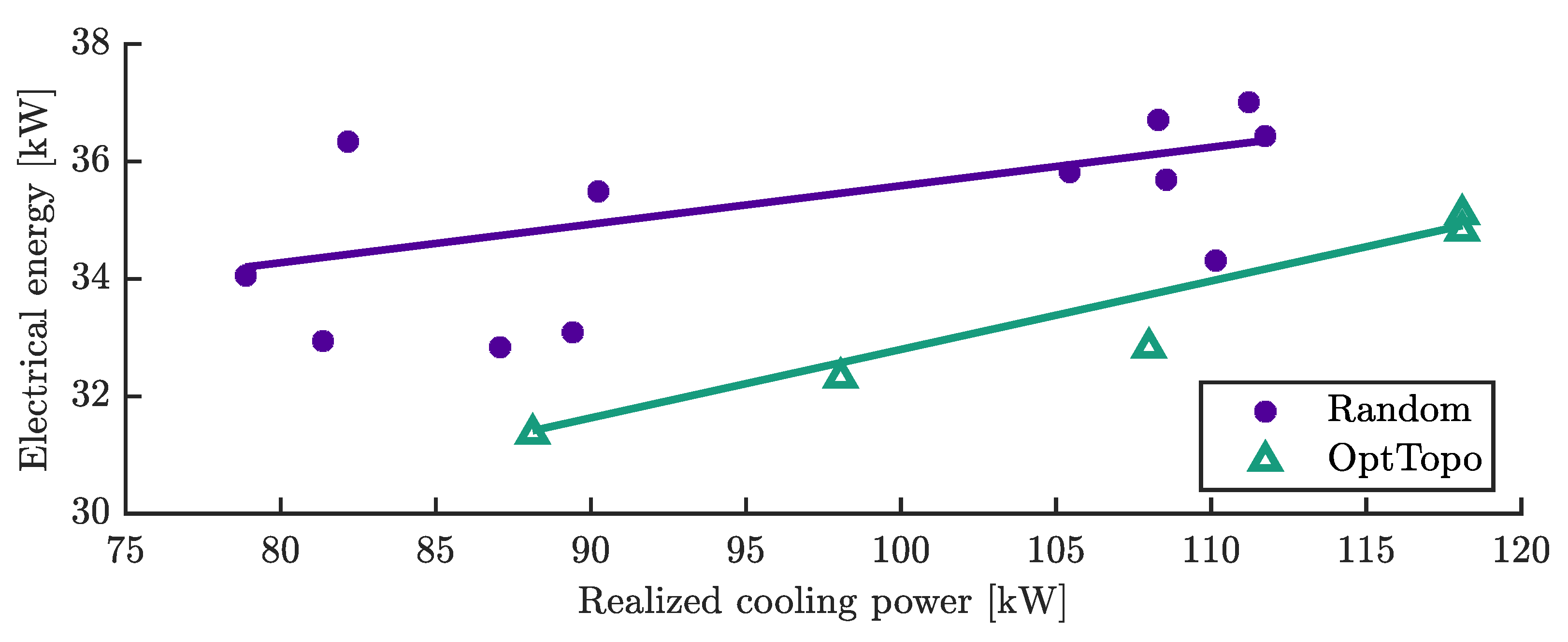
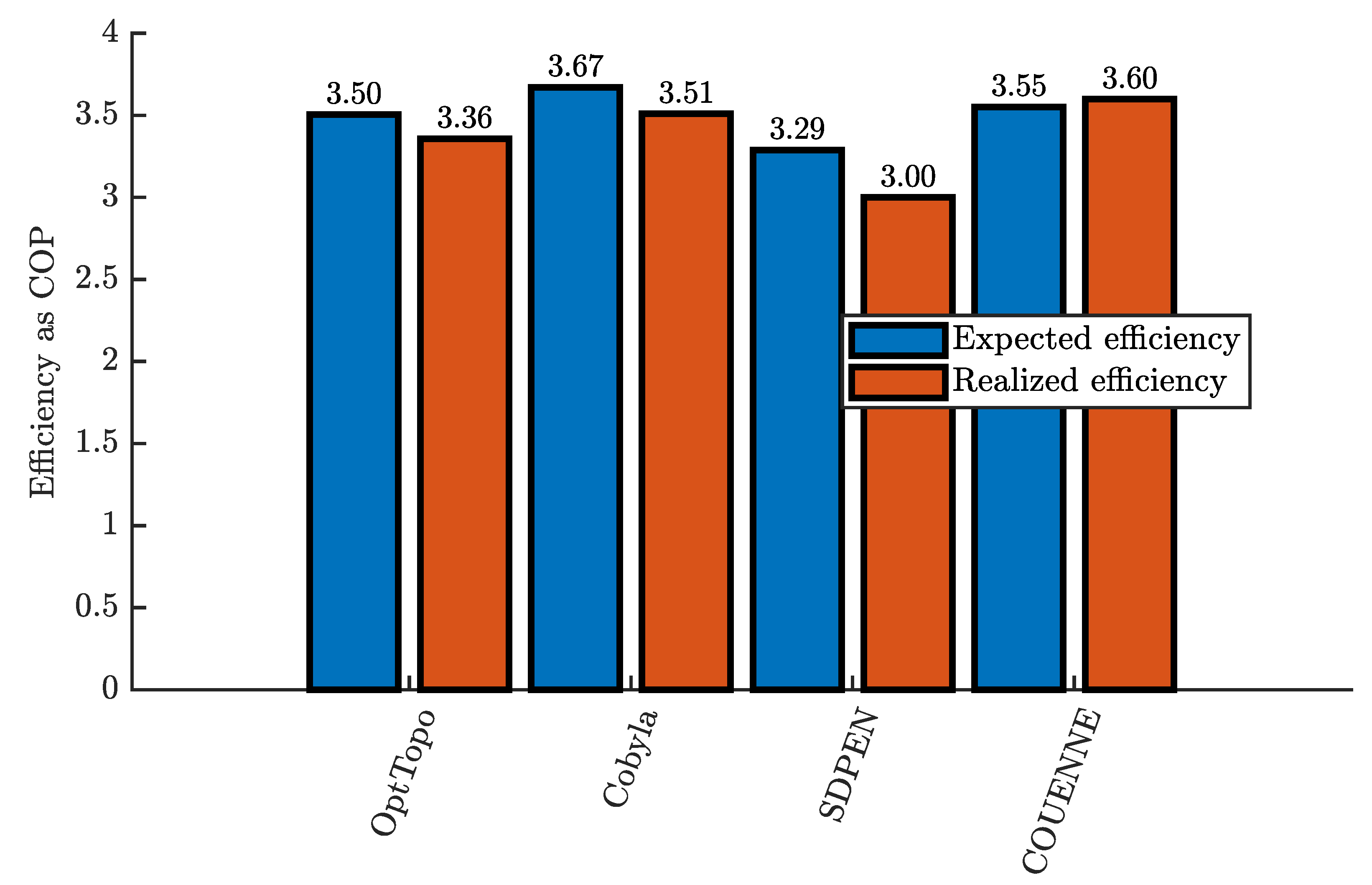
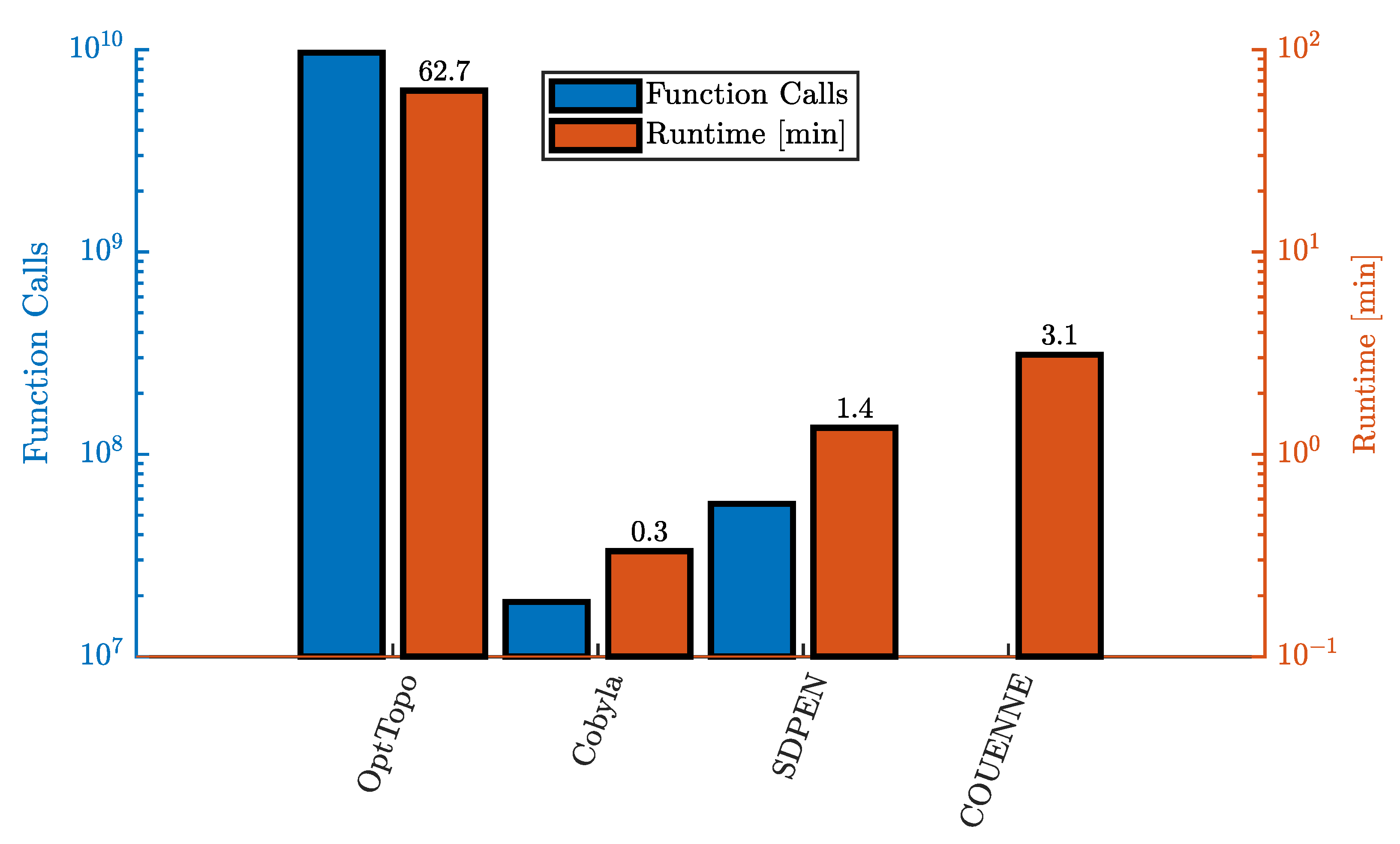
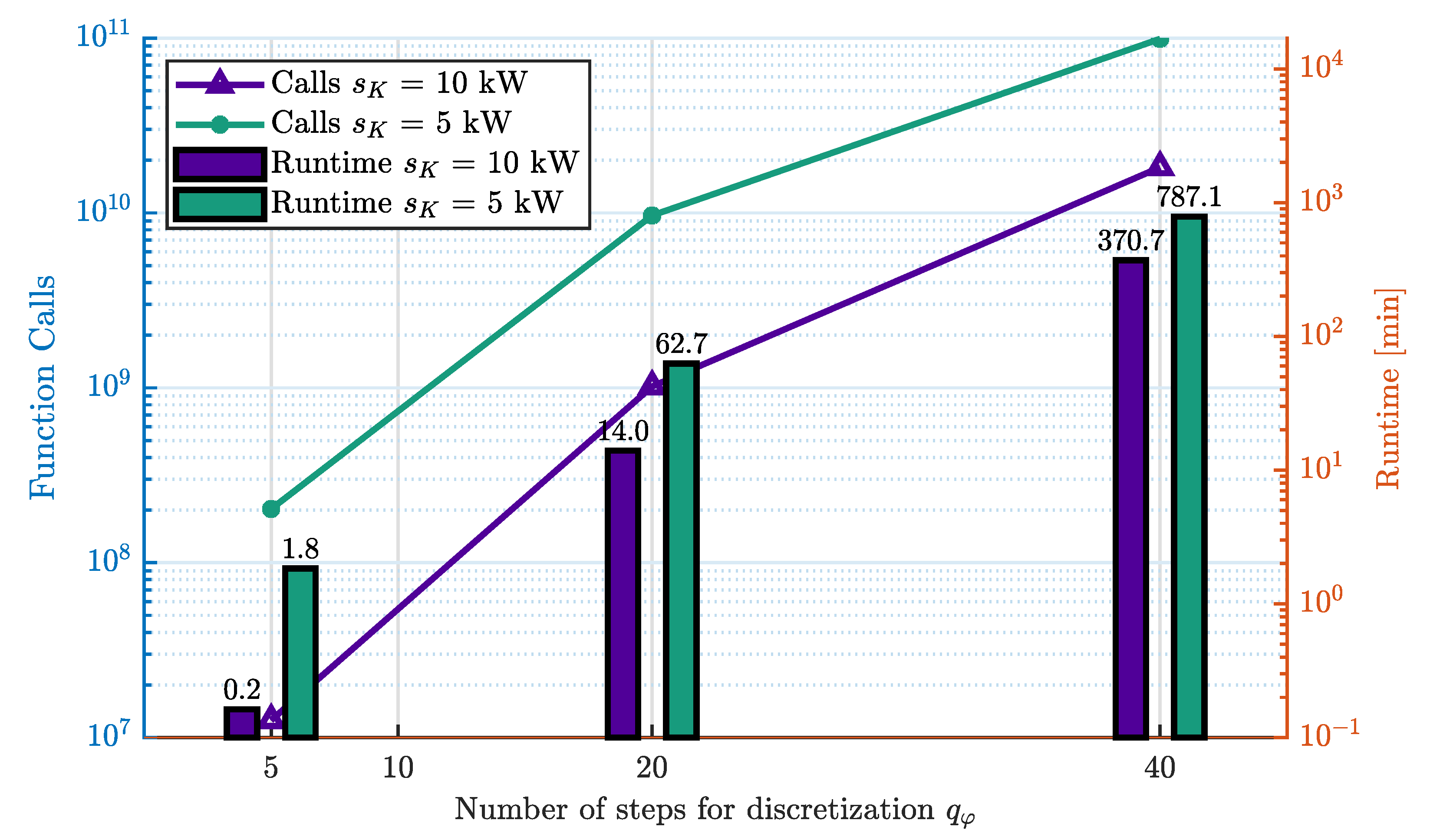
| Variable | Meaning |
|---|---|
| set-point temperature for the cooling tower (CoTo) | |
| , | hysteresis width of the two chillers |
| set pressure for the cooling water (CoW) cycle | |
| set pressure for the chilled water (ChWa) cycle | |
| temperature level between the cooling water cycle and the chillers | |
| temperature of the consumer |
| (74, 83.4] | (83.39, 92.8] | (92.8, 102.2] | (102.2, 111.6] | (111.6, 121] |
| Variable | |||||
|---|---|---|---|---|---|
| Value | bar | bar |
| Combinations | Function Calls | Runtime in Min | |
|---|---|---|---|
| 5 Steps | 625 | 2.03e8 | 1.8395 |
| Factor | 256 | 47.6512 | 34.0853 |
| 20 Steps | 16 × 104 | 9.6732 × 109 | 62.7 |
| Factor | 16 | 10.2292 | 12.5534 |
| 40 Steps | 256 × 105 | 9.8949 × 1010 | 787.1 |
Publisher’s Note: MDPI stays neutral with regard to jurisdictional claims in published maps and institutional affiliations. |
© 2022 by the authors. Licensee MDPI, Basel, Switzerland. This article is an open access article distributed under the terms and conditions of the Creative Commons Attribution (CC BY) license (https://creativecommons.org/licenses/by/4.0/).
Share and Cite
Thiele, G.; Johanni, T.; Sommer, D.; Krüger, J. Decomposition of a Cooling Plant for Energy Efficiency Optimization Using OptTopo. Energies 2022, 15, 8387. https://doi.org/10.3390/en15228387
Thiele G, Johanni T, Sommer D, Krüger J. Decomposition of a Cooling Plant for Energy Efficiency Optimization Using OptTopo. Energies. 2022; 15(22):8387. https://doi.org/10.3390/en15228387
Chicago/Turabian StyleThiele, Gregor, Theresa Johanni, David Sommer, and Jörg Krüger. 2022. "Decomposition of a Cooling Plant for Energy Efficiency Optimization Using OptTopo" Energies 15, no. 22: 8387. https://doi.org/10.3390/en15228387
APA StyleThiele, G., Johanni, T., Sommer, D., & Krüger, J. (2022). Decomposition of a Cooling Plant for Energy Efficiency Optimization Using OptTopo. Energies, 15(22), 8387. https://doi.org/10.3390/en15228387






